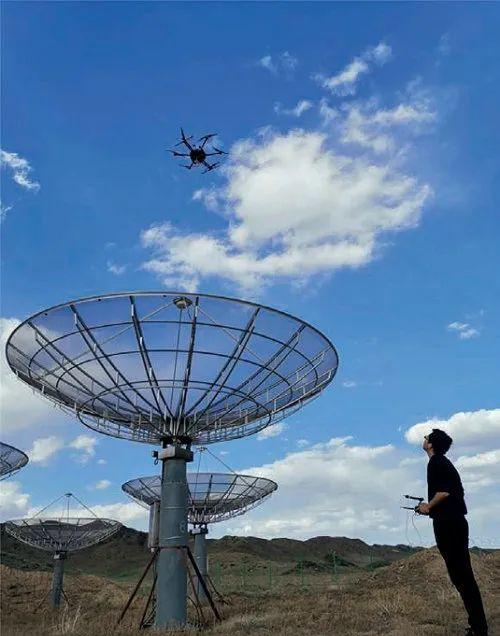The beam pattern of a radio telescope reflects the intensity of the telescope's response to astronomical signals in different directions, which is extremely important for calibrating telescope data and producing accurate astronomical images, but accurately measuring the beam of an radio telescope is challenging. Antenna beam map measurements with drones are a new technology that has emerged in recent years, and multiple teams are experimenting with this technique internationally. The Tianlai Experimental Team of the National Astronomical Observatory and the Optical Electromechanical Laboratory of Hangzhou Dianzi University successfully jointly carried out the measurement experiment of measuring the beam UAV of the radio telescope, and its first measurement results have been published recently.
Traditional antenna beam measurement methods often use hot air balloons, satellites, astronomical sources, etc. Compared with the hot air balloon method, the UAV control is convenient, fast and flexible; compared with the satellite method, the UAV can carry out experiments with the signal source of the required frequency at any selected time, with high controllability; compared with the astronomical source method, the artificial signal source has a high strength and can measure a weak multi-stage side flap. During the experiment, the research team used the UAV to carry a measuring device to accurately measure and analyze the beams of the Tianlai disc-shaped radio telescope under the far-field conditions of flying at an altitude of more than 300 meters. The results show that the measurement results of the main lobe are consistent with the measurement results of traditional astronomical sources, and the method of UAV measurement beam can accurately measure the weak sidelobe structure, and the coincidence with electromagnetic simulation is good.

Figure 1. Drones with tianlai disc telescopes
Figure 2. Left: drone and experimental device; Right: Signal source wrapped in copper foil and coupled pole antenna below
In the series of experiments, the researchers made their own high-stability broadband signal source and dipole antenna, which were mounted on the bottom of the DJI Matrix 600 Pro drone. Through programming control, the UAV can autonomously complete take-off, move, hover, land and other actions according to the pre-designed flight route. By analyzing gps information recorded by the drone and signal strength data observed by the tianlai digital correlator, the researchers can measure the telescope beam. During the data analysis process, the researchers also considered a variety of factors that may affect accurate measurements, such as electromagnetic interference from the drone itself, RTK electromagnetic interference, UAV yaw error, and polarization direction error. The researchers also compared the differences in measurement results over long spans and found that the drone's measurements maintained good stability and consistency, indicating that the measurements of the method were highly credible.
Figure 3. The beams of telescopes measured at different times and at different flight altitudes show good consistency
The Tianlai Experimental Project is a neutral hydrogen survey test project built and operated by the National Astronomical Observatory, located in Dahongliuxia Township, Barikun County, Hami District, Xinjiang. By surveying the redshifted neutral hydrogen, the Tianlai project can use the intensity mapping method to obtain baryon acoustic oscillations in the large-scale structure of the universe, and then measure the expansion history of the universe and determine the dark energy state equation.
The research work was jointly completed by the Institute of Mechanical and Electronic Engineering of Hangzhou Dianzi University and the Tianlai Project Team of the National Astronomical Observatory, and the main authors include Zhang Juyong and Liu Jingxin of Hangzhou Dianzi University, Wu Fengquan and Li Jixia of the National Astronomical Observatory. The research work has been supported by the National Natural Science Foundation of China," the Astronomical Joint Fund, the Key Fund, and the Frontier Science Foundation of the Chinese Academy of Sciences. The paper has now been published in the IEEE Antennas and Propagation Magazine.
Thesis Link:
https://ieeexplore.ieee.org/document/9638547。
Rotating Editor-in-Chief: Ran Li
Editor-in-charge: Yuan Fengfang
Editors: Zhao Yuhao, Qiqi
National Astronomical Journal of China, November 2021
The past and present lives of infrared telescopes